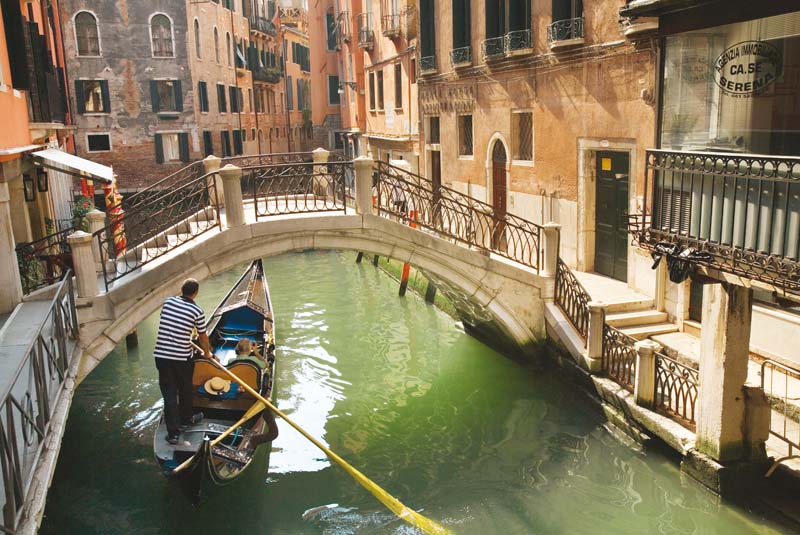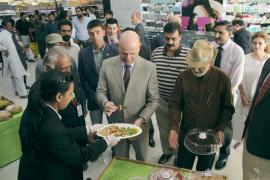
The journey begins
Venice is a city built on more than 100 small islands. Interestingly, there are no cars or roadways here — just canals, bridges and boats, which builds the illusion of a doll-like, make-believe city. As we walked towards the main square, Piazza San Marco, and admired St Mark’s Basilica — a marvel of Italo-Byzantine architecture with its exquisite mosaics — we spotted posters and notices reminding us that the art biennale awaited us.
Titled ‘All The World’s Futures’, the expansive 56th Venice Biennale is curated by Okwui Enwezor, the first African curator of the show, and runs from May to November this year. The Biennale showcases the works of 136 artists representing 89 nationalities and exhibits are scattered across the city, from the Giardini — which is home to ‘pavilions’ or dedicated exhibit spaces curated by artists from each participating country — to the Arsenale (a former shipyard and naval depot) and outlying areas.
The first show we looked at was at the Palazzo delle Prigoini, a historical building and former prison, where we were introduced to the work of Taiwanese artist Wu Tien-Chang titled ‘Never Say Goodbye’. As we entered the space, a curtain was raised and amid flashy light bulbs, a video installation came to life. It displayed a masked sailor, robotically walking to Taiwanese music. Around the room, a light-box installation displayed eerily illuminated faces in various Renaissance garbs against a modern cityscape. Tien-Chang’s pieces awed and irked us, as they melodramatically spoke of the tension between the human ‘soul’ and ‘physique’, as well as the various roles man has to play.
Walking on ahead, a little fatigued, we spotted a little inviting garden, and proceeded to rest for a while on its benches. Here, we noticed something strange — a ‘chopped-off’ tree we stood next to had a little sign next to it, which read, ‘Ursula Von Rydingsvard — USA’. A closer look at the space around us made us realise we were in Yorkshire Sculpture Park, with meticulously engineered cedar sculptures that merged with the surroundings so well that they were hard to discern. Rydingsvard’s other sculptures in stone and glass made us contemplate the passage of time — an effect heightened by the historical neighborhood surrounding the park. Heading out, we spotted a faint red square (the emblem of the Biennale) on a poster far ahead. Following the red sign, we arrived at the Central Pavilion of Giardini — the original historical spot for the Biennale, where 30 national pavilions can be found. For the next three to four hours, we wandered amongst the artworks, many of which contained strong references to history and capitalist ideas.
 Which face will you put on?: A delightful array of beautiful masks at a typical mask vendor’s shop in Venice. PHOTO COURTESY: THEBRIDALGUIDE.CA
Which face will you put on?: A delightful array of beautiful masks at a typical mask vendor’s shop in Venice. PHOTO COURTESY: THEBRIDALGUIDE.CAThe Russian Pavilion, with work by Irina Nakhova, turned out to be my favourite at the Giardini. As we entered the space, we found a huge gas mask sculpture fixed to the floor, with its respiratory tube disappearing into a wall. Behind the giant mask were a pair of life-like eyes. What shocked us was that the eyes moved, nervously looking here and there, often in a desperate plea towards the viewer. How was this piece even created? What could it mean? In history, the gas mask has been a symbol for nuclear fallout. But today, it means something else: humanity’s inability to safeguard its environment and keep it’s air clean enough to breathe. Another work that resonated with me was Pamela Rosenkranz’s pool of pink-tinged water at the Swiss Pavilion. As I tiptoed close to the 6-foot high wall to see the liquid, I thought of harmful chemical treatments and floods and their devastating effects.
In the brightly painted, custard-yellow British pavilion, twisted, phallic sculptures screamed out ‘Sarah Lucas’ — any art aficionado could recognise the former YBA’s (Young British Artists) signature style. Lucas’ aim was, as her statement suggested, to have having the “appearance of a dessert” in her work and to “flood the pavilion with sunlight and put everyone in a good mood”. Lucas successfully achieved these two goals, but the work left one questioning why, after more than two decades, this YBA prodigy has not moved beyond the humdrum of provocative art and titillating imagery.
My East is your West
A number of prominent Pakistani artists such as Imran Qureshi, Khalil Chishtee, Bani Abidi, and Huma Mulji were represented at the Biennale either in pavilions, such as Azerbaijan (the oil-rich nation could afford to host two national pavilions) and Iran, or in independent displays. These works were housed in historical buildings or at the Arsenale (a former military complex for the Italian navy).
 Visitors admire one of the three mobiles trees, part of “Revolutions” by French artist Celeste Boursier-Mougenot at the French pavilion on May 5 in Venice. (GABRIEL BOUYS/AFP/GETTY IMAGES)
Visitors admire one of the three mobiles trees, part of “Revolutions” by French artist Celeste Boursier-Mougenot at the French pavilion on May 5 in Venice. (GABRIEL BOUYS/AFP/GETTY IMAGES)Pakistani artist Rashid Rana and Mumbai-based artist Shilpa Gupta were represented together in the Palazzo Benzon, in the centre of Venice on the Grand Canal. Their joint presentation, My East is Your West, was funded by an Indian philanthropic organisation, The Gujral Foundation. “Whilst we share a common history, we have a divided present,” explained Director and Founder Feroze Gujral of The Gujral Foundation. “We are now working together for a more collaborative future.”
Presented in collaboration with the Lahore Biennale, Rana’s piece ‘Shuhuud-o-shaahid — mashhuud’ created a virtual connection between Venice and a mirrored room in Lahore. In both spaces, visitors viewed and interacted with each other via a livestream, thus, blurring the boundaries between the viewer and the viewed, and, according to Rana, “drawing a reflection of the ‘self’ in an image of the ‘other’”.
Rana felt, with artists from two historically tense countries coming to converse under one umbrella, his and Gupta’s works subvert “nation state representation” as is traditional at Venice, while also addressing this very problem. This made us question, did Pakistan not need its own pavilion? Or in this globalised world where international galleries represent many local artists, would that have been pointless?
A great part of our Venetian adventure consisted of visits to mask vendors, postcard retailers and cafes to gorge on pizzas and hot chocolate. At every corner, gelato shops served a unique variety of flavours, and immigrants sold fake branded bags to wide-eyed tourists, ever ready to fold up the displays at the slightest hint of policemen.
After two intense days of absorbing the sights and sounds of the bustling little city, we sat across a canal on our last night and watched the water softly lap beside the dimly lit homes. In the background, a singer crooned in a language we knew little of, but her voice was enough to soothe us. In that moment, I realised that the art Venice had to offer was not limited to the Biennale or its ageless buildings — it lay all around us.
Shanzay Subzwari is an artist and art writer based in Karachi.
She tweets @ShanzaySubzwari
Published in The Express Tribune, Sunday Magazine, November 8th, 2015.






































COMMENTS (5)
Comments are moderated and generally will be posted if they are on-topic and not abusive.
For more information, please see our Comments FAQ